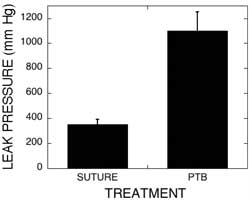
Reattachment of severed blood vessels following surgery or trauma is critical for limb survival. PTB is ideal for blood vessel anastomosis as it provides a water-tight seal that prevents blood leakage, even at supra-physiological pressures, as shown in Figure 11.
 |
| Figure 11. Hydrodynamic leak pressure in re-anastomosed ex vivo pig artery immediately following repair by PTB or standard microsurgical technique. |
Repair of a surgically transected femoral artery in Sprague-Dawley rats was used as the animal model for determining the applicability of PTB for vessel repair (8). RB was applied to the transected ends and a distal cuff was pulled over the proximal end and irradiated in situ with green light. Patency was evaluated immediately 1 hour post-treatment by releasing the clamps and establishing blood flow without leakage from the artery (n=10/group). (see video) In other groups patency was checked at 8 weeks post-treatment and the repair site examined for inflammation, scarring, fibrosis and aneurysm at time of euthanasia (up to 8 weeks) following PTB or microsurgical repair.
Related Publications
8. O'Neill, A. C., M. A. Randolph, K. E. Bujold, I. E. Kochevar, R. W. Redmond, and J. M. Winograd (2009) Photochemical sealing improves outcome following peripheral neurorrhaphy. J Surg Res 151, 33-39.
Research Projects
Mechanisms for light activated protein crosslinking
Closure of surgical wounds
Cornea: sealing incisions and transplantation
Peripheral nerve repair
Tendon repair
Blood vessel repair
Neocartilage generation













